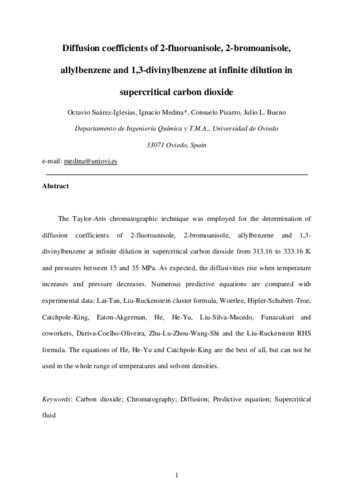Diffusion coefficients of 2-fluoroanisole, 2-bromoanisole, allylbenzene and 1,3-divinylbenzene at infinite dilution in supercritical carbon dioxide
Palabra(s) clave:
Carbon dioxide
Chromatography
Supercritical fluid
Fecha de publicación:
Versión del editor:
Citación:
Descripción física:
Resumen:
The Taylor-Aris chromatographic technique was employed for the determination of diffusion coefficients of 2-fluoroanisole, 2-bromoanisole, allylbenzene and 1,3-divinylbenzene at infinite dilution in supercritical carbon dioxide from 313.16 to 333.16 K and pressures between 15 and 35 MPa. As expected, the diffusivities rise when temperature increases and pressure decreases. Numerous predictive equations are compared with experimental data: Lai-Tan, Liu-Ruckenstein cluster formula, Woerlee, Hippler-Schubert-Troe, Catchpole-King, Eaton-Akgerman, He, He-Yu, Liu-Silva-Macedo, Funazukuri and coworkers, Dariva-Coelho-Oliveira, Zhu-Lu-Zhou-Wang-Shi and the Liu-Ruckenstein RHS formula. The equations of He, He-Yu and Catchpole-King are the best of all, but cannot be used in the whole range of temperatures and solvent densities
The Taylor-Aris chromatographic technique was employed for the determination of diffusion coefficients of 2-fluoroanisole, 2-bromoanisole, allylbenzene and 1,3-divinylbenzene at infinite dilution in supercritical carbon dioxide from 313.16 to 333.16 K and pressures between 15 and 35 MPa. As expected, the diffusivities rise when temperature increases and pressure decreases. Numerous predictive equations are compared with experimental data: Lai-Tan, Liu-Ruckenstein cluster formula, Woerlee, Hippler-Schubert-Troe, Catchpole-King, Eaton-Akgerman, He, He-Yu, Liu-Silva-Macedo, Funazukuri and coworkers, Dariva-Coelho-Oliveira, Zhu-Lu-Zhou-Wang-Shi and the Liu-Ruckenstein RHS formula. The equations of He, He-Yu and Catchpole-King are the best of all, but cannot be used in the whole range of temperatures and solvent densities
ISSN:
Colecciones
Ficheros en el ítem





